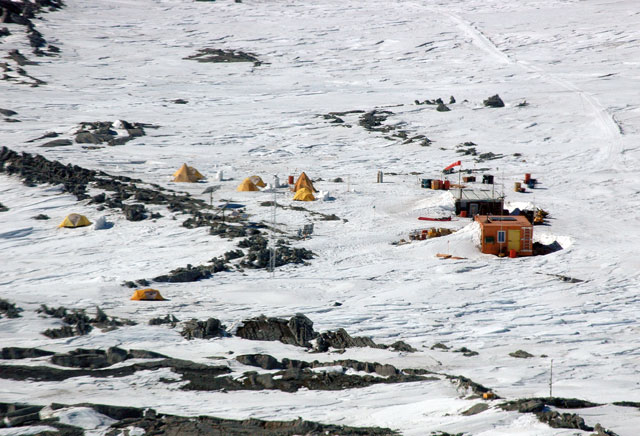Neverending storyMount Erebus offers endless possibilities for research into volcanoesPosted June 3, 2011
Mount Erebus appears benign from the comfort of McMurdo Station The world’s southernmost active volcano looks to be nothing more than a tremendous pile of whipped cream from a distance, impossibly broad at the base, rising to a sloppy and misshapen top — not at all like a classic volcanic cone. Its ever-present plume pours out of the crater like smoke from a recently snuffed candle. But the 20-minute helicopter ride from sea level to near the 3,794-meter-high crater rim offers an altogether different perspective. The first things you see are spiky ice towers that dot the summit area of the volcano. They form when warm fumarolic gases escape through fissures in the underlying rocks and freeze in the frigid air. The speedy aerial ascent and the volcano’s looming bulk almost create a feeling of vertigo. The smell of sulfur saturates the air after a helo pass near the crater, where a lava lake percolates within. “Erebus is a very interesting volcano in terms of having consistent activity and erupting some, but not erupting too much. It’s an ideal natural laboratory,” says Nelia Dunbar The team, led by principal investigator Phil Kyle “Erebus represents the model volcano and provides a lot of insight into how volcanoes work,” Kyle said. An ideal locationThe fact the volcano is located in Antarctica isn’t why the researchers are interested in studying its processes. Rather, Erebus is a somewhat unique specimen in its own right, starting with its permanent lake of convecting molten lava, one of only a handful known to exist in the world. The two best-known lava lakes that have existed for as long as Erebus are located in Africa — Erta Ale in Ethiopia and Nyiragongo in the Democratic Republic of Congo. In fact, in many ways, the location of Erebus is ideal, aside from the occasional spate of bad weather. The logistics support offered by nearby McMurdo Station makes Erebus more accessible than most lava lakes. Volcanologist Clive Oppenheimer “That doesn’t tend to happen around here,” quips Oppenheimer in a clipped English accent. He has recently returned from an aerial survey of the crater on an afternoon so dry that the Erebus plume is invisible, allowing for unobstructed views of the fiery lake, which is the result of natural convection that continuously cycles magma from a chamber deeper inside the volcano to the surface. Oppenheimer’s specialty covers the noxious brew of gases that Erebus persistently emits, from carbon dioxide to sulfur dioxide. “It never switches off, winter or summer, so it’s probably a relatively important contributor to the Antarctic atmosphere,” he explains. The geochemistry of the gases can also reveal details about the volcano’s plumbing system and the source of the gases, he adds. Infrared spectrometers at the rim collect data on the gases every second by using the lava lake as an infrared lamp. Different gases absorb different wavelengths in the infrared spectrum, providing information on the proportion of each gas. An ultraviolet spectrometer at the field camp uses a different light spectrum to calculate how much sulfur dioxide gas escapes into the atmosphere.1 2 Next |



For USAP Participants |
For The Public |
For Researchers and EducatorsContact UsU.S. National Science FoundationOffice of Polar Programs Geosciences Directorate 2415 Eisenhower Avenue, Suite W7100 Alexandria, VA 22314 Sign up for the NSF Office of Polar Programs newsletter and events. Feedback Form |





